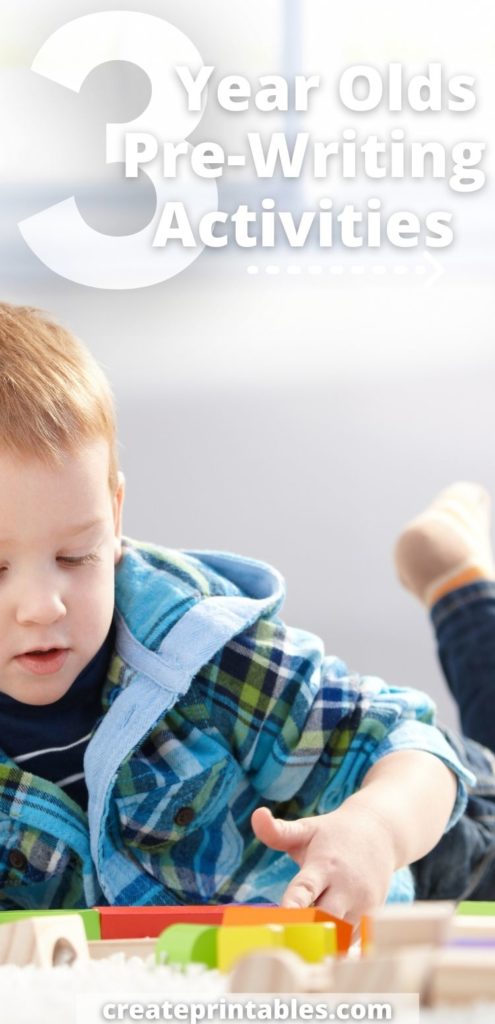You now have a 3-year old and you have been working on pre-writing up until this time. If not, you can go HERE and review that. Then come back and pick up these fun activities for practicing prewriting. So, let’s begin.

Stencil Activity
When toddlers turn three, they can control their movements and they become more sophisticated. To encourage prewriting, we not only recommend, for example, a tracing worksheet, but also a tracing activity before using anything with the alphabet. For this, I like to use stencils. The Montessori method calls them “Metal Insets.”
You basically have a square (4-6 inches long each way) with a cutout inside of a shape. For example, a cut out of a circle, an oval, a square, a rectangle, a triangle, etc. It is important to have both the stencil and the cutout because they are used for 2 different levels of prewriting practice.
Stencil Activity: Step 1
First, use the stencil part. Teach your child how to hold it in place so it doesn’t move. Then, using a pencil, they trace inside the stencil to delineate the shape inside. It will take several tries and some practice, but don’t stress about getting right the first time. This is an important skill to develop. The important thing is that you will know when the child has mastered the skill when you remove the stencil and you can see the shape clearly. It should be a closed shape.
I always begin with the triangle, the rectangle or the square because the skill of drawing a straight line is easier then a curve, like in a circle or oval. Use only the triangle, the square or the rectangle until the skill has been mastered. This is Step 1. Don’t forget to repeat this step with all shapes/stencils until mastered. Then, your child is ready for the next level.
Stencil Activity: Step 2
Step 2 is tracing a shape with the stencil and removing the stencil. Then, with a pencil or a colored pencil, the child will begin drawing a straight line across the shape, moving from left to right, always (unless you live in a country that writes from right to left).
Begin on the left of the square and draw a straight line (as straight as they can) and end at the right end of the shape. See the picture here. I helped my child by placing dots on either end so he would know where to start and where to end.
Try the horizontal lines first and then, when mastered, try the vertical lines as well. Here, my son has been working on these for several weeks, so he can do both side by side. As they get older, they can draw lines closer together and even try diagonal and wavy lines. Repeat this step with all of the shape stencils before moving on to the next level.
Stencil Activity: Steps 3 and 4
Step 3 is having the child steadily hold the stencil in place while they draw the horizontal and vertical lines with the stencil in place. This practice, even though it feels similar to the one in Step 2, the added item (the stencil) helps with finger strength, coordination and fine motor skills. Don’t forget! Always, always, always repeat this activity with all of the stencil shapes before starting the next step.
Step 4 includes the same activity, but in reverse, when it comes to the stencil. You will no longer use the stencil. Your child will now use the cutout to trace the shapes. This step is really hard because it requires a lot more control, not only to hold the cutout in place, but to trace on the outside of the shapes. It can be done, though!
Once the child masters the tracing of the cutout shapes, then they can try drawing the horizontal and vertical lines inside as well.
Alphabet Introduction
At around age 3, you can introduce the alphabet to your child. See the order in which you can introduce them in THIS post. You can have handheld wooden letters, magnetic letters (like the ones kids use on the fridge) or printables like these.
Practice the names of the alphabet letters with your child until the basic ones are mastered. Trace the letters with their index finger. Then, you can begin with the name practice. Take the letters that form your child’s name and put them together in the right order. The benefit of having the loose letters to manipulate is that they can be used for their custom name, form words and more!
Spell “m-a-t” with the letters. See if your child can write those letters with their index finger on a sand tray, on sandpaper letters, and on a tracing worksheet. Then they can try rolling playdough or modeling clay into snakes and form those letters out of the playdough rolls. These sensory activities help polish fine motor skills and are very helpful in the long run. Plus, it is a really fun activity to do together.
I hope that you found these ideas for your 3-year old inspirational!

